04/30/2007, Mayaguana, Bahamas
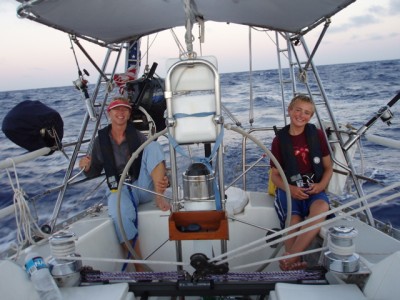
We finally made it out of Puerto Rico and, unfortunately, skipped the Dominican Republic to make up time. Serious cruisers would scoff, but this passage is our first multi-day hop, from Boqueron, Puerto Rico to Mayaguana, Bahamas and is a 'big deal' for us because of the length and because it started with the infamous Mona passage between Puerto Rico and Hispanola (The Mona). For readers not familiar with cruising, on passage there is no place to pull over for the night. The sailing is non-stop and you live the best you can while rolling around on the waves. You would think that sleep would come difficult, but since we (Cath and I) are on three hour watches is doesn't take too long to become so exhausted that you can sleep in conditions, and in positions, that one would think impossible. Of course, with exhaustion comes fatigue and we're extra careful to do things thoughtfully and slowly. They say the first three days are the worst while you adjust to the watch schedule, but after three days we're here! There's a joke that if you want to know what cruising is like, set the alarm for 4 AM. When it goes off, throw on a slicker over your underwear, run out onto the lawn and have your spouse hose you down all the while shouting that its time to reef the mainsail. That's about right.
For you sailors, here's the gory details of the Mona and our wake in it. The Mona is the most difficult passage in the Caribbean, especially upwind, which we weren't. There are two main nasties to deal with. The deepest (second deepest?) part of the Atlantic ocean is the Puerto Rican Trench just North of the The Mona. The Mona lies across a saddle connecting Puerto Rico and Hispanola. The current runs this saddle and spills into the trench creating all sorts of nasty currents. Where you have nasty currents and wind, you have nasty waves. Some punishment is just the price of crossing, but you avoid the worst by staying windward of Hour Glass Shoals. The second problem is the costal front, with associated squalls, that Puerto Rico releases from its West Coast each afternoon. These squalls can be viscous boat breakers that cause masts, and sailors, to tremble in fear. In the late 1400's, Spain lost an entire fleet, except the boat carrying Columbus's gold (read The Last Voyage of Columbus), in the Mona. In our direction, down wind but against frontal progression, we need a fairly long weather window if we want to make the Bahamas in one stretch. So, we've been waiting, with others heading the same way, sometime now for the right window. We got our chance rather suddenly when Friday's forecast improved Friday morning, leaving the four of us scrambling to batten down and get anchors up. First up was beating out against the sea breeze from the West; the breeze away from land was from the North East. Our plan was to get out and head just about due North to out flank the storms we knew would be heading out in the afternoon so we weren't shy about motor sailing though the Westerlies to get on our way. Everyone knew the deal, so we didn't leave together: each as fast as possible and worry about keeping in touch later. The flanking maneuver worked perfect and three of us got to watch the fireworks pass harmlessly behind us as the inevitable progression of cells marched across the Mona. The winds (20-22 kts.) and waves (6-8') were higher than forecast and normally higher than we would have liked, but catching this trailing weather would hopefully allow us to get all the way to the Bahamas before the next system moved in. There was a place where the waves, for some reason, became quite impressive as each of us passed through the area, but they were more height than brute and didn't cause us any harm. The conditions, while robust, moved us rapidly through the area and before midnight, The Mona was, thankfully, behind us: collective sigh.
With The Mona behind us, we trucked along at good speed (average of 7.5 with a peak of 9.5 kts.) down the North coast if Hispaniola during a routine, though bit lumpy, segment. Yesterday evening, as we sat huddled around our dinner bowls in the cockpit, we were joined again by dolphins. Dolphins are a good omen for a voyage and always a delight to see, but this evening was particularly special. The small pod included a wee little baby dolphin! About three feet long, she was soooooo cute!
This morning found us strolling along towards Mayaguana, Bahamas. We lost contact with Paramor III, who was anchored next to us way back in Boqueron, PR, after the second day as we past them by. Losing contact by VHF radio, happens as the boats spread out over time. VHF has a range about about twenty miles. Our cruising friends on Dream Catcher (Tayana 42) that have taken us under wing are about 80 miles behind us, but we're keeping in touch by shortwave radio (turns out transmit is working fine) on a regular basis to exchange positions, for safety, and a few words for morale. They will night over somewhere to time their arrival at Mayaguana with good light for picking through the reefs. We wish we could have given them a few knots of boat speed: they needed more and we needed less. A good anchorage is often 'good' because it is well protected by reefs. The flip side of the protection is the sometimes tricky entrance through the reefs into the anchorage. The passage can be intricate and not something that can be charted. One must be able to clearly see the reefs lying under the surface. Ideally, the sun should be high and just behind you for the best visibility. Doing one of these in the dark is suicide. Thus, one must time ones arrival with the proper position of the Sun. The timing is easier said than done because the wind determines when you'll get there. In our case, we moved too fast and spent the last 18 hours running under just a reefed main to keep our boat speed down. Dream Catcher had a slower time of it and had to hold off for the night for another chance at the anchorage tomorrow. We feel bad that luck worked against their timing, so I'm diving up some conch to give them when they arrive tomorrow.
We've snugged up against the inside of the reef at Mayaguana and have reefs less than 100 meters from the boat all to ourselves: the best snorkeling we've had on the entire trip! So peaceful and gin clear water that makes the boat look like its floating in air over the bottom - really! Mayaguana has a population of 320 and is way, way out there and captures what the Bahamas were like before the tourist invasion. They did not have electricity until 1997!
Cruising camaraderie is a funny thing. We enjoy our new found friends in a here-and-now sense because you never know when weather, break downs, or diverging itineraries will separate you without hardly a chance to say 'goodbye'. Most cruising friends meet in an anchorage or, more often, over the radio as a side effect of going the same way on the same day. On this passage we 'met' several new boats/crews that we will see in person for the first time when we trickle into Mayaguana. Through the days and nights we've talked about weather, passed on coordinates, offered GPS way points, and just said 'hi' at three in the morning to not feel so alone when you're slogging it out in the middle of the ocean without another soul or evidence of mankind in sight.
We 'think' we could have kept going past Mayaguana, but the weather between here and the next stop (Long Island or Rum cay) is riddled with nasty squalls (not that you could tell it from the blue skies and gentle breeze here), so stop we must and wait for another weather window before continuing. You should be getting the feeling that we wait A LOT for the right weather. As an aside, just about everyone cruising the Bahamas and Caribbean depends on Chris Parker for weather information. Chris hosts a weather net for cruisers on the short wave (SSB) each mornings: kind of a morning radio show at 7:00 on 8137.0 MHz, upper side band, if you please. Chris first gives a synopsis of the situation and then each of us (meaning each of us who paid up for the privilege) checks in and he gives us specific weather and sea information about our location and passage. As cruisers we are tied to the weather for our every move, both for comfort and safety, and Chris is our weatherman. Weather forecasts tailored to small boat sailors make the difference between misery and comfort for all of us and Chris is the only show in town, albeit a one man show! He went on vacation one week and we were a little skittish about heading out without Chris as our copilot.
This passage has been one of the biggest challenges we've faced as a family, and we're still running on adrenaline, elated to have seen it through without incident and with morale intact. Our buddy boats all signed off the air, after three days of radio chatter, to catch up on some much needed rest. Shelby cleaned the boat, do laundry, make lunch, and the rest of us went to snorkel on our private reef and dive up some conch. Now the inevitable is catching up with us and now... it is time... to sleep... -the end-
| Caribbean |
|
04/25/2007, La Parguera, Puerto Rico
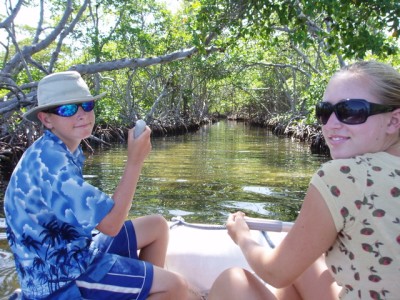
Looks like we have a confirmed weather window to depart tomorrow for Boqueron from where we will cross the Mona Passage Friday or Saturday. There are at least 2 other boats waiting for that window. The plan is to sail as far as the wind (or fatigue) will allow us - ideally to the Bahamas, but we could stop in Dominican Republic if we get beat up. If all goes well, we are looking at 3 days sailing non-stop. Oh boy! La Parguera has been a very good place for cruisers - A short walk from the dinghy dock, there are 2 grocerie stores (not for major provisioning though), a post office, small restaurants, a cheap laundrymat, dive shops, and free Internet access at the library (great when you need to make progress on online classes like Shelby!). You do need to walk (and carry) gas from the gas station and there are no publico to other towns, but you can arrange to rent a car to come pick you up. Water is free at the dock. The town is nicknamed the "Venice of Puerto Rico" because of the mangrove cays that form channels, some of them completely covered overhead. The spot is ideal to learn kitesurfing and we met folks from North Carolina that were spending a 4 day camp doing just that. It also has a bioluminescence bay, like the one in Vieques. On week-ends, Sanjuaners come down and get the anchored boats rocking and rolling when zooming by in sea-lice (aka jetskis) but the week is very quiet.
| Caribbean |
|
04/24/2007, Location: La Parguera, we think.
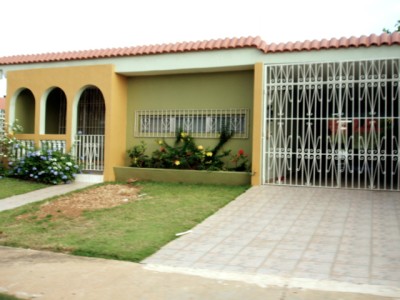
We found Dream Catcher in the anchorage along with some new friends, Andrea and Kim, who have been in their trawler in the harbour for 9 years with their dog Czar. Jim on Dream Catcher was waiting for some alternator parts to arrive while Papa abanded the Canada Dry bottles looking for inspiration for his next idea. He found it the next day. While Canada Dry may not do it, the supreme quality of Arizona Ice Tea cannot be beaten. Oh yes, with the new aluminum body, it can withstand the devastating heat of The Engine!
Anyway, everybody had great fun lending DVD's to each other, since we cruisers have alike tastes. We also went snorkeling off the reef of many fish. We were about to leave for our next destination, when it started to rain. Hard. So we said "Why not stay a bit longer?" The queston that leads to the immobile doom of all cruisers.
| Caribbean |
|
04/19/2007, La Parguera
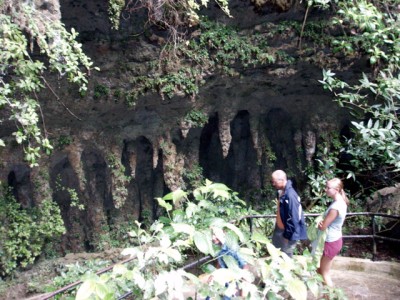
When we left Toni and Gerd, we had our first sighting of dolphins since we started our adventure! That was right after we saw the Portuguese Man-o-War (nasty stingying jellyfish!) We're still hoping for manatees before we come back. We are still at La Parguera, still waiting for a weather window to cross the Mona Passage. It'll be at least another week as we do not want to reiterate the Anegada Passage (we later learned its nickname is Oh-My-God-A Passage) experience. The silver lining is that we are absolutely adoring this place. The snorkeling we had hoped for is out due to the jellyfish infested anchorage, but everything else is grand: friends drove us to provision, we met cruisers also waiting for the weather window, we rented a car, and drove to the Camuy caves (one of the largest underground cave system in the world - 15 km long) and the Arecibo Telescope (the largest telescope in the world - also featured in the highly-praised movie Contact with Jodie Foster!!). Bill is still working on the alternator issue now crafting a ventilating system based on Canada Dry plastic bottles and whatever our limited Spanish use in the hardware store bought us - Shelby was not present at the time :)
| Caribbean |
|
04/14/2007, Cayos de Cana Gorda (Gilligan's Island)
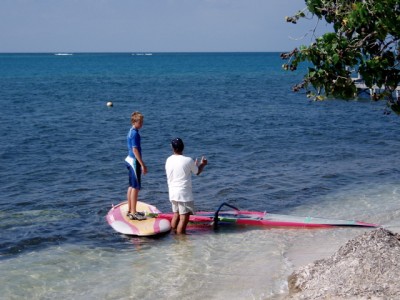
One of the hardest things to do on a boat is get cardio exercise. Well, here in Cayos de Cana Gorda, we've found a way - windsurfing! With the help of Gerd, an americanized German retiree who has a passion for windsurfing and teaching anyone who is willing to learn. In a few days I learned to windsurf (well, the bare minimum, sort of.....but I'm practicing!) and Spencer has been perfecting his skills in that area as well. Gerd's wife, Tony, took us this morning on a beautiful hike (at 7 A.M.) to the Guan�ca Dry Forest Reserve (UNESCO selected treasure) and a visit to the 700 year old Guayacan Tree - maybe Christopher Colombus saw this tree, that would be neat! The wind died and along came our share of bees and mosquitoes. Spencer stepped on a bee and got a nasty sting on the bottom of his foot. Due to this incident, he got to sleep in when we all went hiking, but had to clean the boat :) Daddy is practicing his baking and cooking skills while I learned to splice and made my first successful one just the other day. Mommy has found a new hobby.....napping, when she isn't trying to learn some Spanish. Doesn't look like Mona is going to be passable for at least another week or so. Next week we'll move to the two other south western anchorages in Puerto Rico and wait for a weather window. Wish us luck, gonna be a long one!
| Caribbean |
|
04/11/2007, Cayos de Cana Gorda (Gilligan's Island)

A delightful facet of cruising the less well known regions is the surprise 'anchorages' you happen upon. We planned on a quick overnight in Cayos de Cana Gorda before continuing West, but now that we're here we think we'll stay for a bit. Like so many in the region, this anchorage is entered through reefs that protect it on one side. Reef and mangroves provide protection on the windward side with many 'canals' through the mangroves to explore by kayak, dinghy or swimming. One creek is unusual with a sandy bottom and crystal clear water. Today we saw a couple swimming up this creek and it looks inviting for some light snorkeling as well. (Mangroves provide for a organic rich environment that usually clouds the waters.) The surrounding reefs also look like they might afford some interesting snorkeling. The area is not totally undeveloped, but has protection as a state park. We understand the outer island (Gilligan's Island based on resemblance) can be quite crowded on the weekend, but just a few families were enjoying the picnic tables and grills today. Puerto Ricans seem very family oriented, whether at the beach or on a boat, and tend to do things as a family rather than in age clustered cliques. I met a couple of Germans (not a German couple), one of whom offered to give Spencer free windsurfing lessons tomorrow! The resident splits the year between Seattle and Puerto Rico. His friend is/was on his way to Venezuela for hurricane season, but, like us, decided to stay and enjoy this little bay's eclectic offerings. This afternoon, we lapsed into sophomoric antics like a spring break for four. Highlights included rap blaring while we dared various dives off the 3m platform (that would be the radar arch) and cruising around in stealth mode under the capsized dinghy: just a bunch of silly fun. There appears to be a few restaurants in the area and we might cash in our rain check on Easter dinner if we find a good eatery. Hopefully in a couple of weeks we'll have Internet access and can upload some pictures and read notes on the blog, which we really, really appreciate - keep 'em coming!
| Caribbean |
|
04/11/2007, Isla Caja de Muertos (Coffin Island)
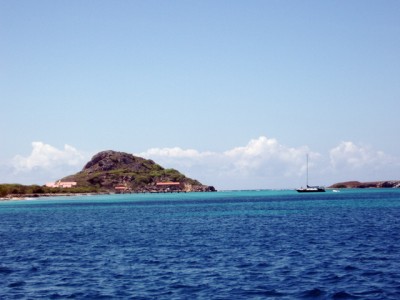
Movin', movin', movin'. After almost a week of visiting PR and limin' around Salinas, we left early for a short sail to Isla Caja de Muertos. More than one legend explains the island's name. Perhaps the best is based on the tragic love of the Portuguese pirate Jose Almeida. His love was killed in an attack shortly after their marriage. He had her 'preserved' in a coffin with a glass top, hidden away in a cave on Coffin Island. Until his capture and hanging, Jose would come back from time to time to view his corpse bride. After his death, the coffin was buried on St, Thomas. So the legend goes... Isla Caja de Muertos is Bahamas in flavor, though with some height to the it at the light house. Looked like a good place for conch and indeed there were dozens of juveniles, but after two hours I had yet to find one large enough to harvest. Being a popular weekend destination and given the snuba divers that came out, I suspect it has been well picked over. Rats on the fish as well: just 'cuda on the sail over. Though the anchorage is popular on the weekends, we shared the island with jsut one other boat half a mile away. Cath and I did a dinghy tour up to the welcoming area (the island is a national park and run much like a national campground with facilities and areas) and took a short hike to the lighthouse. Of all the times to forget the camera! The views were stunning! Along the way we saw what we think was one of the endangered lizards that call the their last home. Small, very brightly colored stripped bodies, with a beautiful, iridescent cyan/blue tail. Just as we were finishing up dinner, Bush touched us (yeach!) as Homeland Security showed up to check us out, being suspicious in a Von Trap sort of way. No problems, but Cath and I were jumping out of skins as they handing her green card back and forth over the water and in the dark. Clearly these guys haven't been on the water long enough to know the water nymphs that jump up and grab anything from green cards to monkey wrenches. Today we're sailing for Cayos de Cana Gorda as we continue East towards the Dominican Republic, though it looks like something vicious is brewing on the East Coast will drag a nasty front through our area (unusual this time of year) early next week. If that happens as forecast, we'll have to hole up for quite a few days before crossing The Mona. And finally, today is Mamy's Birthday - Happy Birthday Mamy!
| Caribbean |
|
04/09/2007, Salinas, Puerto Rico

Saturday we visited Ponce, the second largest Puerto Rican city after San Juan and only 30 min from Salinas. Puerto Rico spent $440M to renovate the city and its shows! It has a beautiful town center with a mix of architecture than reminded us of European and Colonial styles, depending on which building you gaze upon. We ate sandwiches at the Caf� Paris (J) then visited the Parque de Bombas (old Firehouse museum) and saw the Cathedral of Our Lady of Guadalupe. We wanted to visit the Museum of Puerto Rican music but it was closed (even the security guard was not sure why) so we went to check out the new Malec�n (boardwalk) and the Ponce Yacht Club anchorage we heard makes cruisers deaf it is so noisy (close to bars and nightclubs). No loud music that afternoon, but definitely looked like it would have potential in the evening. Most amusing was watching little kids feed $1 bags of sardines to pelicans and tarpons. It was very pleasant seeing Puerto Rican families enjoying Easter together. In general, Puerto Ricans seem mild mannered, pleasant, and polite. We cooled off at Walmart (A/C) to do our last big provisioning run: we don't expect much in the Dominican Republic or Bahamas. Prices were good, but the selection disappointing (no pesto sauce, no maple syrup - yeah we tend to be picky eaters!). We got spoiled at the Sint Marteen Grand March� (the ultimate). We have not been able to find ginger ale in Puerto Rico, so no further evolution of the 'Norska' happy hour drink. It was 95F in Ponce so we opted to pick a cooler destination for our second car rental day and Sunday we set forth to see Toro Negro Forest Reserve in Central Puerto Rico, in the Cordillera mountain chain. Up at the top, the temperature dropped to a record low of 72F and it rained (we found ourselves longing for hot chocolates), which explained the lush sierra palms vegetation and the creeks and croaks of the multitude of frogs surrounding us (the difficult to find, but easy to hear Coqui frog is the state animal of Puerto Rico.) We had the hiking trails pretty much to ourselves, and Spencer made a boat out of bamboo shoots and vines, learning about the laws of physics and fluid dynamics. The day was a great relief from the heat and our legs enjoyed the rare exercise they get. At some point, on the "ruta panoramica", we could see the valleys to the North and South: we were on the Puerto Rico island divide. Back in Salinas, we had hoped to celebrate Easter at a local restaurant, but we could not find a place open that would serve something other than fried food, so we grilled steaks on the boat. In general, the shore food, as we move North, is becoming largely fried fare so we'll just have to wait for meals out until we happen upon lighter cuisine: no more croissants or creative restaurants. Today we are doing major catch-up on math lessons and we plan to depart Salinas tomorrow for Calla de Muertos, a pretty island 8 miles off Ponce, as we get on the move again to Boquer�n, where we'll stage for the infamous Mona Passage to Dominican Republic, the longest passage we'll make so far.
| Caribbean |
|